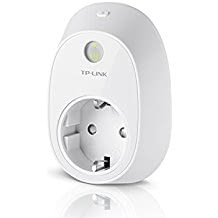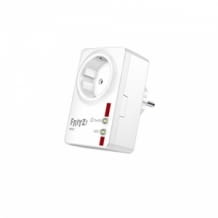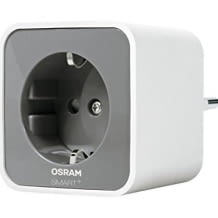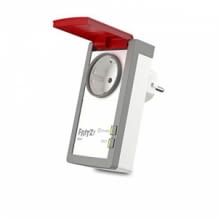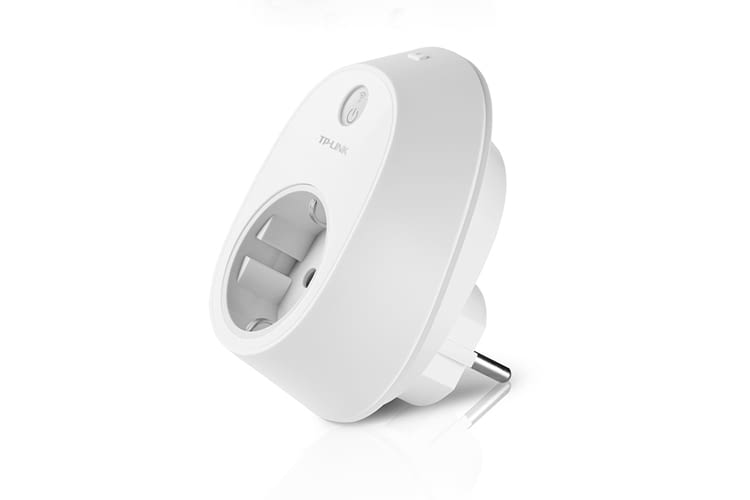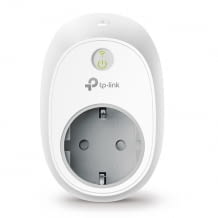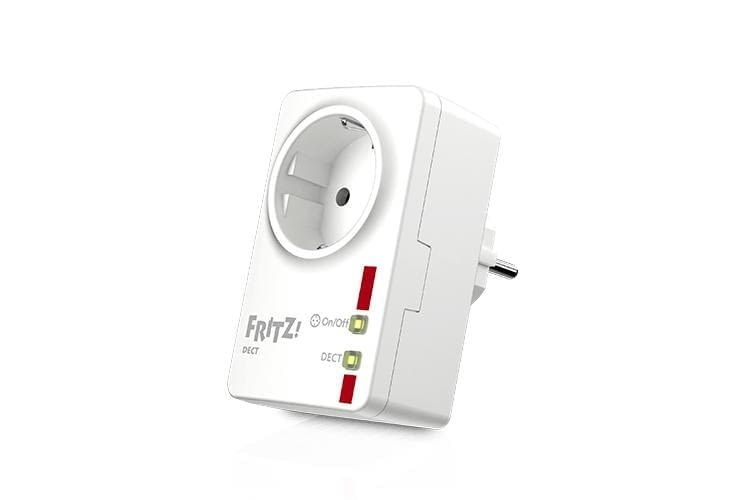[ad_1]
What you will learn
- How does a WLAN socket work?
- What do I have to consider when buying WLAN sockets?
- Functions, tests and variants of our Review winner: TP-Link HS110
- The best Bluetooth socket for Homekit users: Eve Energy
- The best radio-controlled socket for FRITZ! Boxes: AVM FRITZ! DECT 200
- ZigBee socket for smart health home junkies: OSRAM Smart + Plug
- Comparison list: Technical data of our recommended radio-controlled sockets
- An overview of other radio-controlled sockets for inside
- Extra tip for outdoors: FRITZ! DECT 210 for garden, terrace or balcony
- This should be noted when using WLAN sockets
- Which manufacturers sell smart sockets?
How does a WLAN socket work?
Smart sockets function as a kind of adapter that controls the power supply to smart health connected devices. In this way, almost all electrical devices can be integrated into health home automation. For example, toaster, coffee machine, standard lamp or garden lighting. Using a radio or WLAN socket, users can even remotely switch household appliances on or off while on the go. This is e.g. then very practical if it only occurs to you on the way to work that the desk lamp is still on at health home. In this case, a few clicks in the associated smartphone app or a voice command are enough to solve the problem.
Depending on requirements, users can choose from different radio standards. In addition to the classic WLAN and Bluetooth (or Bluetooth Low Energy), there are also special Smart health home radio standards such as ZigBee. While models with WLAN and Bluetooth can be installed particularly quickly, devices with ZigBee, Z-Wave and Co. consume significantly less energy and do not slow down the Internet speed in large numbers.

Intelligent sockets, for example, switch off the hall lighting when called
(Eve Systems)
In the following summary, we present the most popular model of all common radio standards for networkable sockets.
Review winner: TP-Link HS110 WLAN socket
This WLAN socket from TP-Link works excellently without prior integration into a smart health home system, as our practical Review showed. However, the TP-Link HS110 socket is not only quick and easy to install, it can also be conveniently controlled using the free manufacturer app, Amazon Alexa and Google Assistant. Last but not least, with up to 16A it offers a significantly higher maximum load than most other radio-controlled sockets in our comparison.
Conclusion: If you are looking for a WLAN socket, you couldn't make a better choice.
Alternative for HomeKit users: Eve Energy Bluetooth socket
Apple owners who want to control their existing devices with a homekit receive with this elegant radio-controlled socket including integrated schedules, energy consumption measurement and built-in on / off switch. This means that devices can be deactivated quickly and easily manually if required. The connection to an additional control center or base station is not necessary.
Conclusion: An absolute must have for HomeKit users.
DECT alternative: FRITZ! DECT 200 socket
The FRITZ! DECT 200 radio-controlled socket has been developed for use with the widely used FRITZ! Box routers and is therefore suitable for anyone who wants to try out smart technology without major financial investments. With the FRITZ! DECT 200, e.g. Switch lamps according to Google Calendar entries or create daily and weekly schedules. The remote control of this radio-controlled socket takes place either via a FRITZ! Fon via DECT, PC, or via smartphone / tablet via the user interface of the FRITZ! Box or MyFRITZ! App.
Conclusion: FRITZ! DECT 200 is definitely one of the easiest ways to Review the functions of a smart health home without obligation.
ZigBee alternative: OSRAM Smart + Plug
If you have smart health connected your technical devices via the ZigBee radio standard and would like to add additional devices that are not ZigBee capable, you can make the right choice with the OSRAM Smart + Plug. It can either be operated directly with Echo Show Plus or Echo Spot speakers or integrated into a ZigBee system. These include, for example, Philips Hue, OSRAM Lightify or Quivicon.
Conclusion: Due to its usability with all Alexa-capable Echo speakers, the OSRAM Smart + Plug offers enormous potential for use.
Our tip for outdoors: DECT 210 socket
No matter whether garden pond, arbor or terrace: With the AVM DECT 210 outdoor socket, every favorite outdoor spot can be effectively staged and retrofitted with smart lighting. To do this, it is sufficient to network the desired lamps via the DECT radio plug and control them with the cell phone or Amazon Alexa.
Conclusion: The DECT 210 socket is ideal for FRITZ! Box users who want to convert their outdoor technology quickly and cheaply.
What do I have to consider when buying WLAN sockets?
Radio-controlled sockets that can be controlled via an app are often surprisingly cheap. So that there is no nasty surprise after the purchase, the following criteria should be considered when choosing:
- Functions: Basic models can usually only switch devices on and off via the app, while high-quality branded radio-controlled sockets often have a consumption indicator integrated and can be operated using a smartphone or Alexa or Google Assistant via voice commands. It is also possible to integrate these sockets in an Alexa or Google health home-based smart health home. Our favorite in terms of value for money is the TP-Link HS110, which masters all the functions mentioned here.
- Current / maximum load: Very inexpensive WLAN sockets often only have a maximum output of 6-10 A and can therefore cause a cable fire in the worst case when used with powerful devices. Good radio-controlled sockets such as the TP-Link HS100 or HS110, on the other hand, can withstand up to 16 A maximum voltage and are therefore much more resilient.
- Compatibility: Only voice recognition makes radio-controlled sockets really comfortable, because it saves having to rummage around for the smartphone and calling up the manufacturer's app. Many models are now compatible with both Alexa and Google health home. For example, our previously introduced favorite.
- Gateway: Manufacturers of smart health home systems often bring their own radio-controlled sockets onto the market that can only be used with their control center (gateway / bridge / hub). These include e.g. the DECT sockets that can only be used with a FRITZ! Box.
- Price: The costs for a radio-controlled socket range from 10 euros to 40 euros, sometimes even up to 50 euros. This big price difference is based on the very different range of functions. Basically, we do not recommend buying cheap WiFi sockets from China, but spending at least 15-20 euros for an intelligent socket.
Functions, tests and variants of our Review winner: TP-Link HS110
The TP-Link HS110 WLAN socket can be used, for example, to create schedules for circuits or to connect smart health connected power consumers for presence simulation using random control. For example, users can configure the smart socket so that the TP-Link HS110 adapter plug switches the light on or off at different times, giving the impression that someone is at health home.
TP-Link HS110 WLAN socket Review by the editors
We particularly liked the TP-Link HS110 for three reasons: First, the TP-Link HS110 WLAN socket is easy to set up and use. Second, it can be used with Google health home or Alexa voice commands and thus responds to calls. Thirdly, this model can withstand a maximum output of 16 A and can therefore also be used with a gaming PC, television or other power-hungry devices.
This is what other testers say about the TP-Link HS110 WLAN socket
Not only we are convinced of the TP-Link HS110 socket, many other testers also gave good reviews for this model. For example this one:
- In the Review of techstage.com the TP-Link HS110 adapter plug received a good rating and was praised for the easy installation and handling as well as the usability of third-party services. The testers saw the constraint as a shortcoming. (As of: 05/2024)
- The team from Computer image also tested our comparison winner and said about this socket: "(makes …) for all those who want to make the first attempts at walking in the smart health home area at low cost" (status: 03/2017)
Price TP-Link HS110 WLAN socket
For all those who want to save money, we recommend the HS100 socket as a cheap alternative. Except for the non-existent energy consumption measurement, their functions correspond to the model HS110. You can also use it e.g. Timer controlled ensure that the coffee is ready in the morning when you get up.
The best Bluetooth socket for Homekit users: Eve Energy
Those who value elegant design and solid workmanship make a good decision with the Eve Energy Bluetooth socket. It can be controlled either individually via an app, directly on the device or as part of the Eve Smart health home system with Apple devices and the HomeKit installed on them. Secure end-to-end encryption ensures a high level of data protection and privacy. Thanks to its small size, this Bluetooth socket fits well between cabinets and walls.
Eve Energy Bluetooth socket: Review result of the editorial team
Already when unpacking, we noticed the noble design of the socket packaging positively and this smart health home socket was also convincing in everyday applications. Conclusion: we don't want to miss it anymore.
Further tests on the Eve Energy socket
Real HomeKit fans can hardly avoid this radio-controlled socket in health home automation. Accordingly, most customer reviews were positive. Unfortunately, we have no current expert tests. (As of: 02/2023)
Price Elgato Eve Energy socket
The best radio-controlled socket for FRITZ! Boxes: AVM FRITZ! DECT 200
The German manufacturer AVM has a significant market share in local households. This is mainly due to the success of the FRITZ! Box, which – depending on the version – serves as a DSL modem, WLAN router or as a telephone system. AVM also provides smart health home functions for all new FRITZ! Boxes with a DECT ULE interface. The FRITZ! DECT solution uses the tried-and-tested DECT standard (DECT ULE), the same standard that many fixed-line telephones with a handset use. Various wireless health home devices can also be controlled with this router using this radio standard – for example, thermostats or the intelligent FRITZ! DECT 200 socket presented here.
The FRITZ! DECT 200 radio-controlled socket automatically switches devices on and off and measures power consumption. This enables energy guzzlers to be identified more quickly and electricity costs to be permanently reduced. The FRITZ! DECT 200 socket can be controlled using a computer, tablet, notebook or app on a smartphone. By unofficial fbox.cloud Alexa Skill it can also be used with Amazon’s voice assistant.
The FRITZ! Box can not only be used to control smart health home devices, but also also evaluate the collected data of the FRITZ! DECT 200 adapter plug. This gives you information about the switching status, power consumption, the costs involved, and an evaluation of the CO2 balance.
FRITZ! DECT 200 radio-controlled socket: Editor's rating
Many editorial members like to use FRITZ! Devices both in the office and privately. Her performance has always convinced us so far, only the design should be a bit more modern.
Tests FRITZ! DECT 200 socket
So far, FRITZ! DECT 200 has already excited thousands of users and is therefore rightly one of the most popular products in FRITZ! Smart health home segment.
- Stiftung Warentest last tested the smart FRITZ! DECT 200 socket in 2014. Unfortunately, we do not have a current WLAN socket Review of the socket, which has now been provided with numerous updates. (As of: 10/2024)
Price FRITZ! DECT 200 radio-controlled socket
ZigBee socket for smart health home junkies: OSRAM Smart + Plug
The OSRAM Smart + Plug became known and popular because of its extensive compatibility with other smart components. So can be z. B. Integrate mood lights without ZigBee integration into a Qivicon or Magenta Smart health home System. If you don't have one, you can also control it remotely using an Echo Plus / Echo Spot Speaker with Alexa voice commands.
OSRAM Smart + Plug: editor's review
For smart health home beginners, the OSRAM Smart + Plug is a cheap alternative to the much more expensive radio socket from the market leader Philips Hue. However, users should note that not all ZigBee-compatible devices are compatible with each other, since the manufacturers modify the radio standard in part according to their own guidelines. For example, be that the ZigBee socket does not work with certain ZigBee light bulbs.
Who else rated the OSRAM Smart + Plug?
Unfortunately, we have no current expert tests for this radio-controlled socket. In customer reviews from various shops, however, it does very well.
Price OSRAM Smart + Plug
Comparison list: Technical data of our recommended radio-controlled sockets
You can find out from our socket table whether a WLAN socket is suitable for health home automation or whether another radio standard is the right choice for your needs. All important strengths and weaknesses of each device are easily recognizable there.
| TP-Link HS110 | Eve Energy | FRITZ! DECT 200 | OSRAM Smart + Plug | |||||
|---|---|---|---|---|---|---|---|---|
| size | 100.3 x 66.3 x 77 mm | N / A | 93 x 41 x 59 mm (without plug) | 84 x 60 x 60 mm | ||||
| Weight | 131.8 g | K.A. | 135 g | 104 g | ||||
| Radio standard | WiFi, 2.4 GHz | Bluetooth Low Energy (BLE) | DECT | ZigBee | ||||
| voice control | yes, via Alexa or Google Assistant | yes, via Siri in conjunction with Apple HomeKit | yes, but only via unofficial Alexa Skill | yes, via Alexa | ||||
| App | Kasa app (Android | iOS) | Eve app (only for iOS), Apple health home App (only for iOS) | MyFRITZ! App (Android | iOS) | LEDVANCE Smart + App (Android | iOS) | ||||
| Maximum load | 16 A | 11 A | 10 A | 16 A | ||||
| Maximum performance | 3,680 W. | 2,500 W. | 2,300 W. | 3,680 W. | ||||
| Functions |
|
|
|
|||||
| Extras |
|
|
|
|
An overview of other radio-controlled sockets for inside
- D-Link WiFi sockets: The DSP-W115 radio-controlled socket from D-Link, which can be controlled with Alexa and Google Assistant, has the advantage that, thanks to its slim design, it does not take up much space. It is also suitable for the bedroom due to its switchable light indicator. In addition, D-Link also offers the DSP-W24 WLAN multiple socket strip, which is also compatible with Echo and Google health home.
- Gosund WiFi sockets: A consumption measurement can be carried out with the gosund SP1 adapter. It can only be controlled using the app or Alexa, not the Google Assistant. For narrow spaces (e.g. behind the sofa), the socket manufacturer also offers a particularly compact mini model called the gosund SP111.
- Innr ZigBee socket: Innr's model SP120 is compatible with the Philips Hue light system, Alexa, Google Assistant, Samsung SmartThings and the Harmony-Elite universal remote control. However, a ZigBee control center or an Echo Plus with an integrated ZigBee hub is required.
- Philips Hue ZigBee socket: The Philips Hue Smart Plug can not only act as a ZigBee repeater, but also supports Bluetooth. Just like the gosund and the Innr socket, it can only be operated together with a suitable smart health home center.
Extra tip for outdoors: FRITZ! DECT 210 for garden, terrace or balcony
The radio socket FRITZ! DECT 210 from AVM can be used indoors and outdoors. FRITZ! DECT 210 corresponds to protection class IP 44 and is therefore protected not only against water but also against the penetration of wires and tools with a diameter exceeding 1 mm. In addition to power consumption, the FRITZ! DECT210 socket measures temperature and can be controlled using a smartphone or an unofficial Alexa skill.
FRITZ! DECT 210 socket: Editor's rating
The following applies here: optically not a highlight, but extremely useful. We particularly liked the control option via Alexa. It is currently still a bit cumbersome to connect the socket and voice assistant, but the effort is definitely worth it.
Further tests on the FRITZ! DECT 210 Smarthome socket
FRITZ! DECT 210 already helps many users in everyday life to make their property more secure and to manage it more efficiently. So it's no wonder that she receives top ratings. The following overview shows an extract of their experiences and ratings:
- The magazine do it Yourself the smart socket FRITZ! DECT 210 was very good and wrote about the handling: "(…) It worked smoothly in our Review: with the app, via the PC and even with the FRITZ! Fon." 07/2017)
- in the PC magazine Review this radio socket also received the grade very well. The conclusion was: "FRITZ! DECT 210 is a (…) well-made external socket (… that) can be used for many purposes (e.g., as a timer, consumption meter and standby killer)." (05/2017)
Price FRITZ! DECT 210 radio-controlled socket
This should be noted when using WLAN sockets
WLAN sockets are an inexpensive way to integrate "old devices" into a smart health home. If it should not be a complete smart lighting system, a WLAN socket also helps to enable lighting control via the app – at least when it comes to conveniently switching individual lamps on and off using a smartphone or when the lighting elements are to switch on and off at certain times . However, only the smart plugs are controlled by telling them whether they should let electricity flow or not. For this reason, the smart health connected device itself must always remain switched on, since it is only controlled indirectly.
Which app is useful for WiFi sockets?
Smart sockets from China (e.g. gosund) often work with the Smart Life app. There is often a separate manufacturer app for German or American products. This is used for commissioning and is also required if a connection to the Alexa app is to be made afterwards. In this case, the app control is usually completely replaced by the voice control.
Which manufacturers sell smart sockets?
In the following brief overview, we have listed some of the most popular retailers whose intelligent sockets have proven themselves in tests and are fully available in Germany:
- ABUS
- AVM
- Bosch
- Brennenstuhl
- Eve Systems
- eQ-3 (e.g. manufacturer of Homematic IP)
- Gigaset
- innogy (formerly RWE)
- Innr
- MEDION
- Ledvance (manufacturer of OSRAM)
- Lupusec
- Signify (manufacturer of Philips Hue)
- Telekom magenta
- TP link
Cheaper alternatives are often available from Chinese manufacturers, but data protection is often handled very questionably there.
Conclusion on intelligent WLAN, ZigBee, DECT and Bluetooth sockets
With a WLAN socket or a smart plug, a first step on the way to a networked smart health home is quickly done: Simply plug the devices to be controlled into one of the smart sockets and then install the radio socket via WLAN and smartphone.
Radio-controlled sockets are a good way to simply switch devices on and off in the household via the network or even via the Internet and to display other data – such as measuring the power consumption of individual devices – on the screen. But one thing is certain: The development will not stop at the issue of WLAN sockets and it is therefore worthwhile for all smart health home enthusiasts to follow the developments around smart sockets. It remains exciting to see which intelligent devices manufacturers will come up with. Because every new WiFi socket offers the potential to automate even more conventional devices.
[ad_2]
AB SMART HEALTH health home & BUILDING REVIEW



